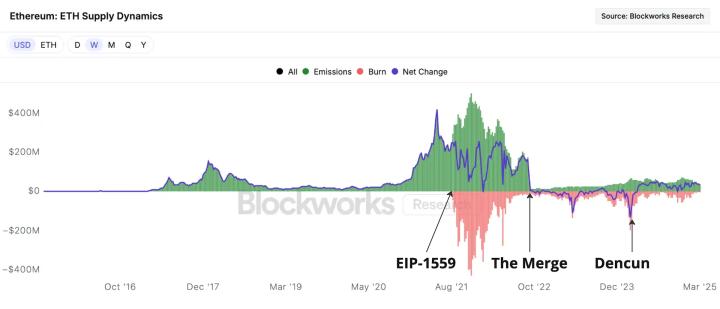Jessy, Jinse Finance
Ethereum's price is just a step away from $4,000, a stark contrast to the scene in April when it plummeted below $1,500 and was universally criticized. In just over three months, its growth has significantly outpaced Bitcoin. In July alone, it rose nearly 60%. From being universally criticized and early ICO whales frantically selling, to now, with evangelists selling door-to-door on Wall Street and whales still making large-scale investments at the $3,800 level.
Looking back now, the rumor circulating at the beginning of the year about "Ethereum changing hands" seems to be verified, with the core power seemingly shifting from early ICO whales and the Ethereum Foundation to traditional Wall Street old money. But is this really the case?
Ethereum is no longer a niche asset for hoarding, with the approval of the Ethereum spot ETF as a dividing line. Previously, Ethereum's technological innovation was the reason for its unshakeable second-place status in the industry. At that time, Ethereum's narrative was about decentralization's ideals, crypto technology's innovation hub, the "world's computer". As crypto integrates into mainstream finance, becoming its gear, Ethereum's narrative has transformed into a story Wall Street can understand - a new narrative of being the infrastructure and settlement layer of the global digital financial system, a platform for RWA and stablecoin issuance and settlement.
July 30, 2025, marks the tenth anniversary of Ethereum's mainnet launch and its genesis block. At this milestone, Ethereum has shed its crypto geek plaid shirt and donned a sharp financial elite suit, stepping on the gas and accelerating towards the traditional financial world.
Crypto's Mainstreaming, Ethereum's Narrative Reconstruction
The turning point occurred in May 2024, when the SEC unexpectedly approved the concentrated listing of Ethereum spot ETF applications.
BlackRock, Fidelity, VanEck's application documents extensively emphasized Ethereum's "compliance", "functionality", and "settlement capabilities", completely different from the previous speculative perspective of "crypto assets". In July 2024, these ETFs began trading, initiating a new capital inflow cycle. According to Bloomberg data, by July 2025, these Ethereum spot ETFs had a total managed asset size exceeding $5.5 billion. The ETF approval is essentially a symbolic event of the traditional world recognizing and accepting Ethereum.
The ETF approval is just the surface. What truly changes the market structure is the formal recognition by mainstream financial institutions of Ethereum's role as a "compliant chain". BlackRock has issued BUIDL on the Ethereum mainnet, a money market fund running on-chain with underlying assets of short-term US Treasury bonds and cash. This move is considered the first native appearance of US Treasury bonds on Ethereum. Subsequently, Franklin Templeton, Fidelity, and other institutions have tokenized assets, with Ethereum and its Layer 2 solutions gradually becoming the underlying settlement platform for issuing and settling these "real-world assets".
Ethereum remains the primary battlefield for stablecoin issuance, with this year's USD1 from the Trump group and the Hong Kong yuan stablecoin from Circle Technology still choosing Ethereum as their main issuance chain.
At the same time, recognition from traditional financial institutions has brought larger, more stable purchasing behavior. Nasdaq-listed SharpLink Gaming has increased its ETH holdings three times in two months, accumulating over 438,000 ETH, surpassing the Ethereum Foundation's holdings and becoming the world's largest institutional holder.
Its Ethereum purchasing strategy is seen as an Ethereum version of MicroStrategy, but unlike MicroStrategy, after a series of capital operations, SharpLink not only obtained substantial funds to buy ETH, but its board chairman also became Ethereum co-founder Joseph Lubin. This company is essentially operated by Ethereum veterans, mimicking Bitcoin's strategy to promote ETH as a "strategic asset" in traditional financial markets. Besides SharpLink, companies like BTCS are also raising funds through convertible notes to purchase Bitcoin.
The people operating ETH haven't changed, just adapting to the times with different operational methods and narrative approaches. New operators have also joined, with this "Ethereum evangelism" wave involving not just institutions listing ETFs and public companies adding to their treasuries, but also a group of discreet yet powerful "storytellers" active in closed-door meetings and investor roadshows, portraying Ethereum as the global financial "settlement layer" and infrastructure for stablecoin issuance and RWA mapping.
Tom Lee, Raoul Pal, and Cathie Wood are gradually shifting their focus from Bitcoin to Ethereum, with narratives quietly switching. Ethereum, once marketed as the "decentralized world computer", now wears a suit and has become the "on-chain clearing network" in traditional financial circles.
Power Not Surrendered, But Extended
Looking deeper, the real power transfer isn't as simple as it appears. This "Ethereum changing hands" isn't about ICO whales fleeing and Wall Street taking over. Wall Street isn't here to take over, but was attracted by Ethereum's ecosystem veterans using familiar language, rules, and structures for a long-term capital game.
SharpLink is a typical example. Institutions highly associated with Ethereum, like ConsenSys, entered SharpLink through private equity financing, with Ethereum co-founder and ConsenSys founder/CEO Joseph Lubin becoming SharpLink's board chairman. Strongly promoting Ethereum strategic reserves at the company level is about establishing a global benchmark, encouraging companies to adopt Ethereum as a treasury reserve and promoting traditional world's acceptance of Ethereum.
Meanwhile, we see the Ethereum Foundation, though less directly visible, still methodically managing Ethereum's upgrades and Layer 2 network distribution. From Polygon to StarkNet, from OP Stack to EigenLayer, power hasn't been surrendered but extended and transformed.
Ethereum's new order, whether in technological development, capital, or narrative, is still established under the control of the Ethereum Foundation and early interest groups. They use new narratives and new shells to collaborate with Wall Street in telling Ethereum's new story: no longer an "idealistic hacker utopia", but the "global digital asset financial backbone". The market indeed buys this, with its growth significantly outpacing Bitcoin in the recent three months.
Ethereum's founder Vitalik once said his life's ideal was to become a bridge for all things. Now, Ethereum hosts numerous stablecoins, on-chain US Treasury bonds, and on-chain US stocks, becoming a bridge between traditional and crypto finance. The other end of the bridge is no longer just crypto geeks and anonymous hackers, but Wall Street lawyers, market makers, ETF traders, and the massive capital structures attempting to tokenize "the entire world".







